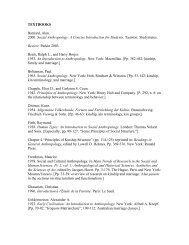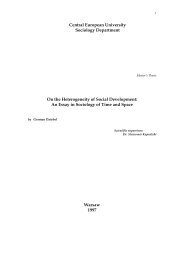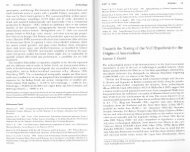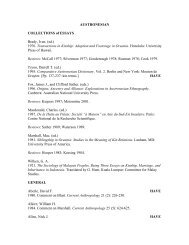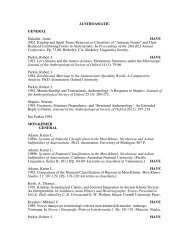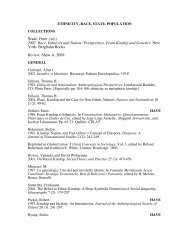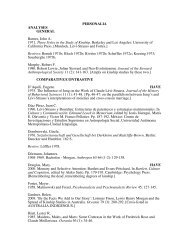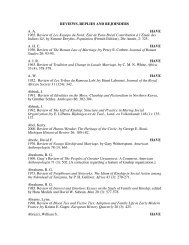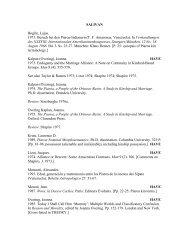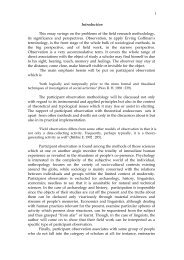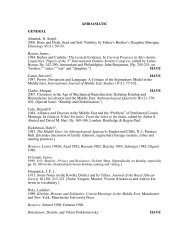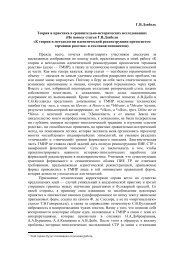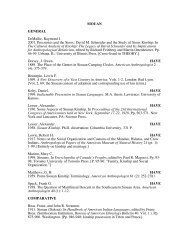5.3.Arawakan - Kinship Studies
5.3.Arawakan - Kinship Studies
5.3.Arawakan - Kinship Studies
Create successful ePaper yourself
Turn your PDF publications into a flip-book with our unique Google optimized e-Paper software.
ARAWAKANGENERALHill, Jonathan D.1985. Agnatic Sibling Relations and Rank in Northern Arawakan Myth and Social Life.In The Sibling Relationship in Lowland South America, edited by Kenneth M. Kensinger.Pp. 25-32. Bennington, VT: Bennington College. (Working Papers on South AmericanIndians 7.)Koch-Grünberg, Theodor.1911. Aruak-Sprachen Nordwestbrasiliens und der Angrenzenden Gebiete. Wien:Anthropologische Gesellschaft. 200 P. [Pp. 82-89: kin terms in 9 Arawakan languages;190-191: comparative Bare and Tariana kin terms.] HAVETaylor, Douglas M.HAVE1957. Marriage, Affinity, and Descent in Two Arawakan Tribes: A Sociolinguistic Note.International Journal of American Linguistics 23 (4): 284-290. [Lokono and IslandCarib.]Taylor, Douglas M.1957. A Note on Some Arawakan Words for man, etc. International Journal of AmericanLinguistics 23 (1): 46-48. [On Arawakan words for mother, husband, and wife.]Taylor, Douglas M.HAVE1961a. Grandchildren versus Other Semidomesticated Animals. International Journal ofAmerican Linguistics 27 (4): 367-370.Taylor, Douglas M.HAVE1961b. Some Remarks on Teknonymy in Arawakan. International Journal of AmericanLinguistics 27 (10: 76-80.MAIPURANCENTRAL MAIPURANMEHINAKUGregor, Thomas.1977. Mehinaku: The Drama of Daily Life in a Brazilian Indian Village. Chicago andLonsdon: University of Chicago Press. [Pp. 270-280: kinship terminology.]EASTERN MAIPURANPALIKURArnaud, Expedito.HAVE1968. Referéncias sobre o Sistema de Parentesco dos Índios Palikúr. Boletim do MuseuParaense Emilio Goeldi. Antropologia 36: 1-21.Dreyfus, Simone.HAVE1981. Le peuple de la rivière du Milieu: Esquisse pour l’étude de l’espace social Palikur.In Orients pour Georges Condominas. Pp. 301-313. Paris: Sudestasie Privat.Nimuendaju, Curt.1926. Die Palikur-Indianer und Ihre Nachbarn. Göteborg: Elanders Boktryckeri
Aktiebolag. [Pp. 81-82: marriage; 127-144: Palikur and Galibi (Carib) kin terms in athematic dictionary.]MANAOGoeje, C. H. de.1948. La langue manao (famille Arawak-Maipure). In Actes du 28e CongrèsInternational des Américanistes. Paris 1947. Pp. 159-171. Paris: Musée de l’Homme.[Extinct. P. 163: kin terms as part of classified vocabulary.]HAVENORTHERN MAIPURANCARIBBEANGARIFUNA (BLACK CARIB)Galvão de Andrade Coelho, Ruy.1955. The Black Caribs of Honduras: A Study in Acculturation. Ph.D. dissertation.Northwestern University. [Pp. 279-286: kin terminology reproduced from Taylor 1951.]Foster, Byron.HAVE1988. Estructura familiar Garifuna: Un analisis comparative. América Indígena 48 (2):233-281. [Marriage system. No kin terminology.]Kerns, Virginia B.1977. Daughters Bring In: Ceremonial and Social Organization of the Black Carib ofBelize. Ph.D. dissertation. University of Illinois at Urbana-Champaign. [Pp. 189-260:kinship system; 342-343: kin terminology.]HAVEKerns, Virginia B.1983. Women and the Ancestors: Black Carib <strong>Kinship</strong> and Ritual. Urbana: University ofIllinois Press.Review: Harding 1984.2d edition: With a foreword by Constance R. Sutton and an afterword by the author.Urbana: University of Illinois Press, 1997.Palacio, Joseph.1982. Food and Social Relations in a Garifuna Village. Ph.D. dissertation. Berkeley:University of California.Porter, Robert W.1984. History and Social Life of the Garifuna in the Lesser Antilles and Central America.Ph.D. dissertation. Princeton University. 844 P. [Pp. 102-164, 297-408: kinship,marriage, residence, kindred.]Pury Toumi, Sybille de.HAVE1993. “Si tu remontes jusqu’à Adam et Eve…” La nomenclature Garifuna de la parenté:L’opposition home/femme. Amerindia 18: 75-91.Solien, Nancie L.1960. Changes in Black Carib <strong>Kinship</strong> Terminology. Southwestern Journal ofAnthropology 16: 144-159.HAVE
Taylor, Douglas M.1938. The Caribs of Dominica. In Anthropological Papers. Bureau of AmericanEthnology, Bulletin 119. Pp. 103-195. Washington: Government Printing Office. [Pp.153-154: list of inalienably possessed nouns, including kin terms.]Taylor, Douglas M.1946. <strong>Kinship</strong> and Social Structure of the Island Carib. Southwestern Journal ofAnthropology 2 (2): 180-212.HAVETaylor, Douglas M.1951. The Black Carib of British Honduras. Viking Fund Publications in Anthropology17. New York: Wenner-Gren Foundation for Anthropological Research. [Pp. 75-88: kinterminology and behavior.]HAVETaylor, Douglas M.HAVE1953. A Note on <strong>Kinship</strong> and Marriage among the Island Carib. Man 53 (175): 117-119.Taylor, Douglas M.HAVE1965. Tradition in Black Carib <strong>Kinship</strong> Terminology. International Journal of AmericanLinguistics 31 (3): 286-292.GUAJIRO (GOAJIRO, WAYU)Fuchs, Helmut.1962. Totemismus und Sozialstruktur der Goajiro. In Akten des 34. InternationalenAmerikanistenkongresses, Wien, 18.-25. Juli 1960. Pp. 585-591. Horn: F. Berger.Goulet, Jean-Guy.1978a. Guajiro Social Organization and Religion. Ph.D. dissertation. Yale University.722 P.Goulet, Jean-Guy.1978b. El Parentesco Guajiro de los Apüshi y de los Oupayu. Caracas: UniversidadCatólica Andrés Bello, Instituto de Investigaciones Históricas, Centro de LenguasIndígenas.Goulet, Jean-Guy.HAVE1981. The Guajiro <strong>Kinship</strong> System: Its Semantic Structure and Social Significance.Anthropological Linguistics 23 (7): 298-325.Gutiérrez de Pineda, V.1950. Organisación social en la Guajira. Revista del Instituto Etnológico Nacional 3 (2):1-304.Kohler, Josef.HAVE1887. Ueber das Recht der Goajiroindianer. Zeitschrift für VergleichendeRechtswissenschaft 7: 381-384. [Marriage, inheritance and postmarital residence.]Saler, Benson.1987. Los Wayú (Guajiro). In Los Aborígenes de Venezuela, edited by Walter Coopens.T. 2. Etnología Contemporánea, edited by Roberto Lizarralde and Haydée Seijas. Pp. 25-146. Caracas: Fundación La Salle de Ciencias Naturales, Instituto Caribe de Antropologíay Sociología. [Pp. 66-73: kin terminology.]HAVE
Watson, Lawrence C.1967. Guajiro Social Structure: A Reexamination. Antropologica 20: 3-36.HAVEWilbert, Johannes.HAVE1957. Verwandtschaftssytem der Goajiro. Zeitschrift für Ethnologie 82 (2): 164-168.Wilbert, Johannes.HAVE1958a. <strong>Kinship</strong> and Social Organization of the Yekuána and Goajiro. SouthwesternJournal of Anthropology 14 (1): 51-60. [Cross-listed in CARIBAN.]Wilbert, Johannes.1958b. Verwandtschaftssystem der Goajiro. Anthropos 53: 279.Wilbert, Johannes.1961. <strong>Kinship</strong> and Social Organization of the Yekuana and Goajiro. Anthropos 56: 291.Wilbert, Johannes.HAVE1970. Goajiro <strong>Kinship</strong> and Eiruku Cycle. In The Social Anthropology of Latin America:Essays in Honor of Ralph Leon Beals, edited by Walter Goldschmidt and Harry Hoijer.Pp. 306-357. Los Angeles: University of California Latin American Center.Wilbert, Johannes.HAVE1976. Kinsmen of Flesh and of Blood: A Comment on Possible SocioeconomicAfricanisms in Goajiro Indian Culture. Contributions of the Latin American AnthropologyGroup 1: 58-66. Washington.LOKONO (ARAWAK)Farabee, William C.1918. The Central Arawaks. Philadelphia: University of Pennsylvania Museum.(Anthropological Publications 9.)Hickerson, Nancy P.1953. Ethnolinguistic Notes from Lexicons of Lokono (Arawak). International Journal ofAmerican Linguistics 19 (3): 181-190. [Pp. 181-184: kin terms.]HAVEPet, Willem.1987. Lokono Dian: The Arawak Language of Suriname. A Sketch of its GrammaticalStructure and Lexicon. Ph.D. dissertation. Cornell University.PARAUJANO (ANU)Rosales, Reina C.HAVE1996. Los Añú de la Laguna de Sinamaica: Sus relaciones de parentesco y matrimonio.Opción 12 (20): 73-87.Wilbert, Johannes.HAVE1959. Zur Soziologie der Parajuano. Zeitschrift für Ethnologie 84 (1): 81-87. [Pp. 83-84:kin terminology.]Wilbert, Johannes.1983. Los Añú (Paraujano). In Los Aborigenes de Venezuela, edited by Walter Coppensand Bernarda Escalante. Pp. 11-32. Caracas: Fundación la Salle de Ciencias Naturales,
Instituto Caribe de Antropología y Sociología. Monografía 29. [Pp. 24-31: kinterminology and social organization. ]HAVETAINOKeegan, William F.1991. An Anthropological Evaluation of Taino <strong>Kinship</strong>. In Proceedings of the 13 thInternational Congress for Caribbean Archaeology, edited by E. N. Ayudi and J. B.Haviser. Pp. 437-445. AAINA, Curacao: Netherlands Antilles.Keegan, William F., and Morgan D. Maclahlan.HAVE1989. The Evolution of Avunculocal Chiefdoms: A Reconstruction of Taino <strong>Kinship</strong> andPolitics. American Anthropologist 91 (3): 613-630.INLANDACHAGUASaignes, Miguel A.HAVE1966. El sistema de parentesco y una possible filiacion bilateral entre los Achaguas.Anuario del Instituto de Antropologia e Historia 3: 17-33. Caracas, Venezuela.BALE (BARE)Pérez, Antonio.1987. Los Bale (Baré). In Los Aborígenes de Venezuela, edited by Walter Coopens. T. 2.Etnología Contemporánea, edited by Roberto Lizarralde and Haydée Seijas. Pp. 413-478.Caracas: Fundación La Salle de Ciencias Naturales, Instituto Caribe de Antropología ySociología. [P. 461: kin terminology.]HAVEBANIWA (WAKUENAI)Engracía de Oliveira, Adélia.HAVE1975. A Terminologia de Parentesco Baniwa. Boletim do Museu Paraense Emilio Goeldi56: 1-34.Grasserie, R. de la.1890. Esquisse d’une grammaire et d’un vocabulaire Baniva. In Congrès Internationaldes Américanistes. Compte-Rendu de la 8ème Session tenué à Paris en 1890. Pp. 616-646. Paris. [Pp. 630-631: kin terms as part of classified vocabulary].Hill, Jonathan D.1983. Wakuenai Society: A Processual-Structural Analysis of Indigenous Cultural Life inthe Upper Rio Negro Region of Venezuela. Ph. D. dissertation. Indiana University. [Pp.33-60: kinship and marriage (no kin terms).] HAVECURRIPACOGranadillo, Tania.2004. Nominal Possessives in the Ehe Dialect of Kurripako: Morphology, Phonology andSemantics. Coyote Papers: Working Papers in Linguistics 13: 31-39.Journet, Nicolas.HAVE1993. Hommes et femmes dans la terminologie de parenté curripaco. Amerindia 18: 40-74.
Journet, Nicolas.1995. La Paix des Jardins: Structures Sociales des Indiens Curripaco du Haut Rio Negro(Colombie). Paris: Institut d’Ethnologie/Musée de l’Homme. [Pp. 139-166: “Dravidian”kinship terminology and marriage structures.]HAVEValentine, Paul.1991. Curripaco Social Organization: A Study in History, <strong>Kinship</strong>, and Marriage in theUpper Rio Negro Valley. Ph. D. dissertation. Pennsylvania State University. [Pp. 257-325: kinship and marriage.] HAVEPIAPOCOPharris de Klumpp, Doloris A.1995. Vocabulario Piapoco-Español. Santafé de Bogotá: Accociación InstitutoLinguistico de Verano.RESIGAROAllin, Trevor R.1979. Vocabulario Resígaro. Lima: Ministerio de Educación; Yarinacocha, Peru:Instituto Lingüístico de Verano.TARIANAAikhenvald, Alexandra Y.1999. Tariana Texts and Cultural Context. München: LINCOM EUROPA. [Pp. 31-32:kin terms.]HAVEAikhenvald, Alexandra Y.2003. A Grammar of Tariana from Northwest Amazon. Cambridge: Cambridge UniversityPress. [See especially pp. 68-70, 166-168 for the analysis of kin terms.] HAVEWAPISHANANWAPISHANA (WAPIXANA)Diniz, Edson S.HAVE1968. A terminologia de parentesco dos índios Wapitxana. Boletim do Museu ParaenseEmilio Goeldi. Antropologia 34: 1-16.Herrmann, Lucila.HAVE1946-1947. A organização social does Vapidiana do Território do Rio Branco. Sociologia8: 119-134, 203-215, 282-304; 9: 54-84. São Paulo.Keary, W.1947. Wapishana Grammar and Dictionary. Georgetown: Daily Chronical Printers andPublishers.Tracy, Frances V.1972. Wapishana Phonology. In Languages of the Guianas, edited by Joseph E. Grimes.Norman: University of Oklahoma. (Summer Institute of Linguistics Publication 35.)Wilbert, Johannes.HAVE1986. Contributions to Wapishana <strong>Kinship</strong> Nomenclature. Antropologica 65: 77-100.
YUKUNAJacopin, Pierre-Ives.1981. La Parole Generative de la Mythologie des Indiens Yukuna. Ph. D. dissertation.Lepettit-Tremblay. [Pp. 37ff: kinship system and terminology.]HAVESOUTHERN MAIPURANBOLIVIAN-PARANATERENABaldus, Herbert.1937. Tereno-Texte. Anthropos 32: 528-544. [Pp. 540-541: kin terminology.]Cardoso de Oliveira, Roberto.1959. Matrimônio e solidariedade tribal Terena. Revista de Antropologia 7: 31-48.Oberg, Kalervo.HAVE1948. Terena Social Organization and Law. American Anthropologist 50 (2): 283-291.CAMPAASHENINCAKindberg, Willard.1975. Parentesco en Campa Asháninca. Lima: Instituto Lingüístico de Verano. 5 p.(Datos Etno-Lingüísticos 11.)Payne, David L., Judith K. Payne, and Jorge S. Santos.1982. Morfología, Fonología y Fonética del Asheninca del Apurucayali (Campa-ArawakPreandino). Yarinacocha, Perú: Instituto Lingüístico de Verano. [Pp. 290-298: kinterminology.]HAVERojas Zolezzi, Enrique.1994. Los Ashaninka: Un Pueblo Tras el Bosque. Contribución a la etnología de losCampa de la Selva Central Peruana. Lima, Perú: Pontificia Universidad Católica delPerú, Fondo Editorial. [Pp. 303-304: kin terminology.]HAVECAMPARenard-Casevitz, France-Marie.1998. On Double Language and the Relativity of Incest: The Campa Sociology of aDravidian-Type Terminology. In Transformations of <strong>Kinship</strong>, edited by MauriceGodelier, Thomas R. Trautmann, and Franklin E. Tjon Sie Fat. Pp. 244-251. Washingtonand London: Smithsonian Institution Press.Weiss, Gerald.1975. Campa Cosmology: The World of a Forest Tribe in South America.Anthropological Papers of the American Museum of Natural History 52 (5): 217-588. [P.549: kin terminology.] HAVEMACHIGUENGAD’Ans, André-Marcel.HAVE
1974. Estructura Semantica del Parentesco Machiguenga (Arawak). Revista de MuseoNacional (Lima) 40: 341-361.Casevitz, France-Marie.HAVE1976. Du proche au loin: Étude du fonctionnement des systèmes de la parenté et del’alliance Matsiguenga. In Actes du XLIIe Congrè International des Américanistes. Paris,2-9 Septembre 1976. Vol. 2. Social Time and Social Space in Lowland South AmericanSocieties. Pp. 121-139. Paris: Société des Américanistes.Johnson, Allen.2003. Families of the Forest: The Matsigenka Indians of the Peruvian Amazon. Berkeley,etc.: University of California Press. [Pp. 158-168: analysis of a “Dravidian” kinterminology.]HAVEJohnson, Orna R.1978. <strong>Kinship</strong> Decisions among the Machiguenga: The Dravidian System in a SmallScale Society. In Social Correlates of Kin Terminology, edited by Kenneth M. Kensingerand David J. Thomas. Pp. 54-62. Working Papers on South American Indians 1.Bennington, VT: Bennington College.Löffler, Lorenz G., and Gerhard Baer.1978. Zur Verwandtschaftsterminologie der Matsigenka, Ost-Peru. L’Uomo 2 (1): 53-70.Rosengren, Dan.HAVE2002. Cultivating Spirits: On Matsigenka Notions of Shamanism and Medicine (and theResilience of an Indigenous System of Knowledge). Anales Nueva Época 5: 1-30. [Theuse of kin terms between a shaman and his spirit “brother” in the overall context ofexchange.]Snell, Wayne W.1964. <strong>Kinship</strong> Relations in Machiguenga. M.A. thesis. Hartford, CT: Hartford Seminary.PRE-ANDINENANTIMichael, Lev D.HAVE2008. Nanti Evidential Practice: Language, Knowledge, and Social Action in anAmazonian Society. Ph.D. dissertation. University of Texas – Austin. [Pp. 53: the use ofkin terms and the absence of personal names; 3-7: “Dravidian” (in the author’sclassification) kinship system, residence, household.]PURUSAPURINAFacundes, Sidney da Silva.1994. Noun Categorization in Apurinã (Maipuran, Arawakan). M.A. thesis. University ofOregon. [Pp. 55-130: “Possession and Noun Categorization” (extensively on kinshippossession).]Facundes, Sidney da Silva.HAVE1997. On the Lexical Properties of Classificatory Nouns in Apurinã (Arawakan/Maipuran).Papers Presented at the 4 th Buffalo-Toronto Student Conference in Linguistics (September1997), edited by Cori Grimm, Eve Ng, and Julie Olenn. Pp. 1-26. Buffalo, NY: Departmentof Linguistics. [Mostly on body-part terms and theoretical issues.]
Facundes, Sidney da Silva.2000. The Language of the Apurinã People of Brazil (Maipure/Arawak). Ph.D. dissertation.State University of New York at Buffalo. [Pp. 163-166: kinship possession.] HAVEINAPARIParker, Stephen G.1995. Datos de la Lengua Iñapari. Lima: Ministerio de Educación; Yarinacocha,Pucallpa, Perú: Instituto Lingüistico de Verano.PIRO (YINE)Gow, Peter.1991. Of Mixed Blood: <strong>Kinship</strong> and History in Peruvian Amazon. Oxford: ClarendonPress.Reviews: Viveiros de Castro 1993; Wade 1993.Gow, Peter.1997. O parentesco como consciência humana: o caso dos Piro. Mana 3 (2): 39-65.Löffler, Lorenz G., and Gerhard Baer.HAVE1974. The <strong>Kinship</strong> Terminology of the Piro, Eastern Peru. Ethnologische ZeitschriftZürich 1: 257-282.Matteson, Esther.HAVE1954. The Piro of the Urubamba. Kroeber Anthropological Society Papers 10: 1-100.[Pp. 88-89: kin terminology.]WESTERN MAIPURANAMUESHADuff-Tripp, Martha.1998. Diccionario Yanesha' (Amuesha) - Castellano. Lima, Perú: Instituto Lingüístico deVerano.Santos-Granero, Fernando.1990. The Power of Love: The Moral Use of Knowledge amongst the Amuesha of Central Peru.London and Atlantic Highlands, NJ: Athlone Press. [Pp. 315-316: kin terminology.] HAVE



